Macrosegregation Evolution in Eutectic Al-Si Alloy under the Influence of a Rotational Magnetic Field
Abstract
1. Introduction
2. Materials and Methods
2.1. Alloy
2.2. Solidification Facility
- The capsule with the thermocouples and a solidified sample; the sample (Part 1) is solidified inside the capsule. The capsule contains three parts; the upper and middle parts are made from alumina ceramic (Part 2), and the lower part is copper (Part 4) due to its high thermal conductivity. The thickness of the ceramic is 0.2 mm, which makes no significant temperature difference inside the mold where the sample is located and outside the ceramic mold wall during the solidification process. Long, narrow apertures were placed in longitudinal directions on the surface of the capsule to insert 13 pieces of K-type thermocouples around the capsule at different heights. To avoid direct contact with the coolant, a quartz tube (Part 3) was used to cover these 13 thermocouples.
- The furnace with a programmable temperature controller: the melting process for the sample takes place in a vertical tube furnace. This furnace has four separate heating zones (Part 5). Each zone can be adjusted independently by using a programmable temperature controller.
- Control unit: This unit controls the samples’ movement toward the cooling unit under the furnace. A step motor can adjust the velocity of movement (Part 6).
- The MagnetoHydroDynamic stirring (MHD) inductor: its task is to apply an external RMF to the molten liquid during the solidification experiments (Part 7).
- Cooling unit (Part 8): Water was used as the coolant. Cooling the sample is accomplished by submerging the copper block into water.
- Basement: It holds the whole solidification facility (Part 9).

2.3. Solidification Experiments
2.4. Measuring Methods
- The macro-segregation: different macro-segregation patterns result from changes in magnetic induction values (B). The macro-segregation evolution in each sample is observed by analyzing the macroscopic photos.
- The average of the area fraction of the eutectic was measured by the Image J software by all stirred and non-stirred steps. The measurement process is performed on the macroscopic photos.
- The distribution of Si concentration is analyzed using a Scanning Electron Microscope (SEM) equipped with an Energy-Dispersive Spectroscope (EDS). The analysis is performed along the axis of the samples at different locations. The samples were divided into 16 parts with 0.45 mm × 2 mm dimensions along the diameter. The average Si concentration was measured in every part.
3. Results
3.1. Qualitative Analysis of Microstructure
- A distinct segregation pattern is observed in all samples, in which the primary aluminum (white areas) and eutectic structure (gray areas) solidified at the sample’s edges. In contrast, there is an almost pure eutectic structure in the center channel areas of the samples (Figure 5).
- One may note that the pure eutectic structure in the center channel areas has the shape of the CTL segregation pattern. However, the side arm freckles of the CTL have an opposite direction to that reported in the literature by Roósz [22].
- The primary silicon solidification is different in each sample. i.e., the primary silicon is not solidified in the second part of the sample A when 20 mT of magnetic induction is applied (Figure 5A). However, in samples B and C, the primary silicon is solidified into unique periodic “arc-like colonies” (black areas in Figure 5B,C). The arc-like colonies are more apparent in the case of sample C (B = 100 mT) than in sample B (B = 60 mT) due to the reason that the applied magnetic induction is higher. On the other hand, the primary silicon in sample D is solidified between the eutectic side arm freckles of the CTL segregation pattern (Figure 5D).
- Figure 5C shows that the amount of the primary silicon in the periodic arc-like colonies decreases over time. However, the amount of the eutectic structure increases in the CTL segregation before each colony.
3.2. Quantitative Analysis of Microstructure
3.3. The Si Concentration Distribution
4. Discussion
- (i)
- At the edges of the samples, the melt flow velocity is high. For that, the eutectic coupled growth will be destroyed and replaced by the separated growth of eutectic phases. The leading phase is the α-Al, which rejects the Si atoms as it grows. The fluid flows transport the rejected Si atoms from the s/l front to the pure liquid, for which, there is an increase in the Si concentration in the liquid and a decrease in its concentration near the s/l front at the edges. Therefore, the primary aluminum solidified along the edges of the samples (Figure 11II.a). The primary aluminum phase grows in a dendritic growth manner. The dendrites develop secondary arms which reject the Si atoms as they grow. The melt flow has a limited ability to penetrate the dendritic structure and transport the Si atoms between the dendrites, which in turn will cause the Si concentration between the aluminum dendrites to increase. As a result, an inter-dendritic eutectic structure solidifies at the edges.
- (ii)
- The melt flow velocity is zero at the sample’s center channel area, which maintains the coupled eutectic growth mechanism, and solidifies a pure eutectic structure.
- (iii)
- The eutectic structure is solidified as a CTL segregation pattern due to the turbulent flow (Figure 11II.b). It was mentioned before that Taylor-Gortler vortices appear along the sidewall of the cylindrical mold when the laminar flow loses its stability and becomes turbulent. The T-G vortices transport the rejected solute in both directions between the mushy zone and the pure liquid. Willer reports a significant amplification of the radial flow when the T-G vortex impinges on the mushy zone, which means that the transported solute by the radial flow is enhanced momentary along the mushy zone [24].
- (iv)
- Over time, the concentration of the Si will significantly increase in the pure liquid due to the cumulative transportation of the rejected Si atoms from the s/l front. When the concentration is increased above a critical value, the solidification of the primary silicon occurs. The results reveal that the segregation pattern of the primary silicon is highly related to the value of the magnetic induction (B). Higher magnetic induction means more transported Si atoms and a higher Si concentration in the liquid, therefore solidifying the primary silicon in distinct segregation patterns. For example, during step 2 of the C sample solidification (B = 100 mT), the primary silicon solidified into periodic arc-like colonies (Figure 11II.c). In contrast, when the magnetic induction is low, the Si concentration in the liquid doesn’t reach the critical value that allows the primary silicon solidification as in the case of sample A when 20 mT was applied in step 2.
5. Conclusions
Author Contributions
Funding
Data Availability Statement
Acknowledgments
Conflicts of Interest
References
- Zimmermann, G.; Weiss, A. Directional solidification of dendritic microstructures in microgravity and with forced melt flow. Microgravity Sci. Technol. 2005, 16, 143–149. [Google Scholar] [CrossRef]
- Eckert, S.; Nikrityuk, P.; Willers, B.; Räbiger, D.; Shevchenko, N.; Neumann-Heyme, H.; Travnikov, V.; Odenbach, S.; Voigt, A.; Eckert, K. Electromagnetic melt flow control during solidification of metallic alloys. Eur. Phys. J. Spec. Top. 2013, 220, 123–137. [Google Scholar] [CrossRef]
- Zimmermann, G.; Weiss, A.; Mbaya, Z. Effect of forced melt flow on microstructure evolution in AlSi7Mg0.6 alloy during directional solidification. Mater. Sci. Eng. 2005, 413, 236–242. [Google Scholar] [CrossRef]
- Metan, V.; Eigenfeld, K.; Räbiger, D.; Leonhardt, M.; Eckert, S. Grain size control in Al–Si alloys by grain refinement and electromagnetic stirring. J. Alloys Compd. 2009, 487, 163–172. [Google Scholar] [CrossRef]
- Veres, Z.; Roósz, A.; Rónaföldi, A.; Sychev, A.; Svéda, M. The effect of melt flow induced by RMF on the meso- and micro-structure of unidirectionally solidified Al–7 wt.% Si alloy Benchmark experiment under magnetic stirring. J. Mater. Sci. Technol. 2022, 103, 197–208. [Google Scholar] [CrossRef]
- Steinbach, S.; Ratke, L. The Influence of Fluid Flow on the Microstructure of Directionally Solidified AlSi-Base Alloys. Metall. Mater. Trans. A 2007, 38, 1388–1394. [Google Scholar] [CrossRef]
- Nikrityuk, P.; Eckert, K.; Grundmann, R. A numerical study of unidirectional solidification of a binary metal alloy under influence of a rotating magnetic field. Int. J. Heat Mass Transf. 2006, 49, 1501–1515. [Google Scholar] [CrossRef]
- Wang, X.D.; Ciobanas, A.; Baltaretu, F.; Bianchi, A.M.; Fautrelle, Y. Control of the Macrosegregations during Solidification of a Binary Alloy by Means of a AC Magnetic Field. Mater. Sci. Forum 2006, 508, 163–168. [Google Scholar] [CrossRef]
- Eckert, S.; Räbiger, M.M.D.; Zimmermann, G.; Schaberger-Zimmermann, E. The impact of melt flow on the grain orientation in solidifying metal alloys. Mater. Sci. Eng. 2012, 27, 012051. [Google Scholar] [CrossRef]
- Eckert, S.; Willers, B.; Nikrityuk, P.; Eckert, K.; Michel, U.; Zouhar, G. Application of a rotating magnetic field during directional solidification of Pb–Sn alloys: Consequences on the CET. Mater. Sci. Eng. 2005, 413, 211–216. [Google Scholar] [CrossRef]
- Cole, G.; Bolling, G. Augmented natural convection and equiaxed grain structure in casting. AIME Met. Soc. Trans. 1966, 236, 1366–1368. [Google Scholar]
- Zhang, H.; Wu, M.; Rodrigues, C.M.G.; Ludwig, A.; Kharicha, A. Directional Solidification of AlSi7Fe1 Alloy Under Forced Flow Conditions: Effect of Intermetallic Phase Precipitation and Dendrite Coarsening. Metall. Mater. Trans. A 2021, 2021, 3007–3022. [Google Scholar] [CrossRef]
- Kovács, J.; Rogozsán; Rónaföldi, A.; Roósz, A. Unidirectional solidification of Sn-Pb alloys under forced melt flow. In IOP Conference Series: Materials Science and Engineering; IOP Publishing: Bristol, UK, 2012. [Google Scholar]
- Shevchenko, N.; Neumann-Heyme, H.; Pickmann, C.; Schaberger-Zimmermann, E.; Zimmermann, G.; Eckert, K.; Eckert, S. Investigations of fluid flow effects on dendritic solidification: Consequences on fragmentation, macrosegregation and the influence of electromagnetic stirring. In IOP Conference Series: Materials Science and Engineering; IOP Publishing: Bristol, UK, 2017. [Google Scholar]
- Lim, S.; Yoon, E.; Kim, J. The effect of electromagnetic stirring on the microstructure of Al-7 wt% Si alloy. J. Mater. Sci. Lett. 1997, 16, 104–106. [Google Scholar] [CrossRef]
- Croker, M.; Fidler, R.; Smith, R. The characterization of eutectic structures. Proc. R. Soc. A 1973, 335, 15–37. [Google Scholar]
- Shingu, P.H.; Kurosaki, M. Separated Eutectic’ Structure of Unidirectionally Solidified Al–Si Eutectic Alloy Caused by Forced Convection Flow. Trans. Jpn. Inst. Met. 1986, 27, 546–551. [Google Scholar] [CrossRef][Green Version]
- Zhongming, R.; Jinze, J. Formation of a separated eutectic in Al-Si eutectic alloy. J. Mater. Sci. 1992, 27, 4663–4666. [Google Scholar] [CrossRef]
- Kim, Y.W.; Shingu, P.H. The effect of the fluid flow strength on macro-segregation in the unidirectionally solidified structure of eutectic Al-Si. J. Mater. Sci. Lett. 1990, 9, 241–243. [Google Scholar] [CrossRef]
- Zhiqiang, C.; Junze, J.; Dong, L.; Xianshu, Z.; Cho, Y.; Oh, Y.; Shim, J. Thermodynamic criterion of separated eutectic phenomena. J. Mater. Sci. 1998, 33, 2313–2317. [Google Scholar] [CrossRef]
- Rónaföldi, A.; Kovács, J.; Roósz, A. Solidification Facility Equipped with A Magnetohydrodynamic Stirrer; H-3515 Miskolc-Egyetemváros; University of Miskolc (UOM): Miskolc, Hungary, 2006. [Google Scholar]
- Roósz, A.; Kovács, J.; Rónaföldi, A.; Kovács, A. Effect of High Rotating Magnetic Field on the Solidified Structure of Al–7wt.%Si–1wt.%Fe Alloy. Mater. Sci. Forum 2013, 752, 57–65. [Google Scholar] [CrossRef]
- Veres, Z.; Rónaföldi, A.; Kovács, J.; Roósz, A. Periodically changing rod distance in unidirectional solidified Al-Al3Ni eutectic. J. Cryst. Growth 2019, 506, 127–130. [Google Scholar] [CrossRef]
- Willers, B.; Eckert, S.; Nikrityuk, P.; Räbiger, D.; Dong, J.; Eckert, K.; Gerbeth, G. Efficient Melt Stirring Using Pulse Sequences of a Rotating Magnetic Field: Part II. Application to Solidification of Al-Si Alloys. Metall. Mater. Trans. B 2008, 39, 304–316. [Google Scholar] [CrossRef]
- Roplekar, J.; Dantzig, J. A study of solidification with a rotating magnetic field. Int. J. Cast Met. Res. 2001, 14, 79–95. [Google Scholar] [CrossRef]

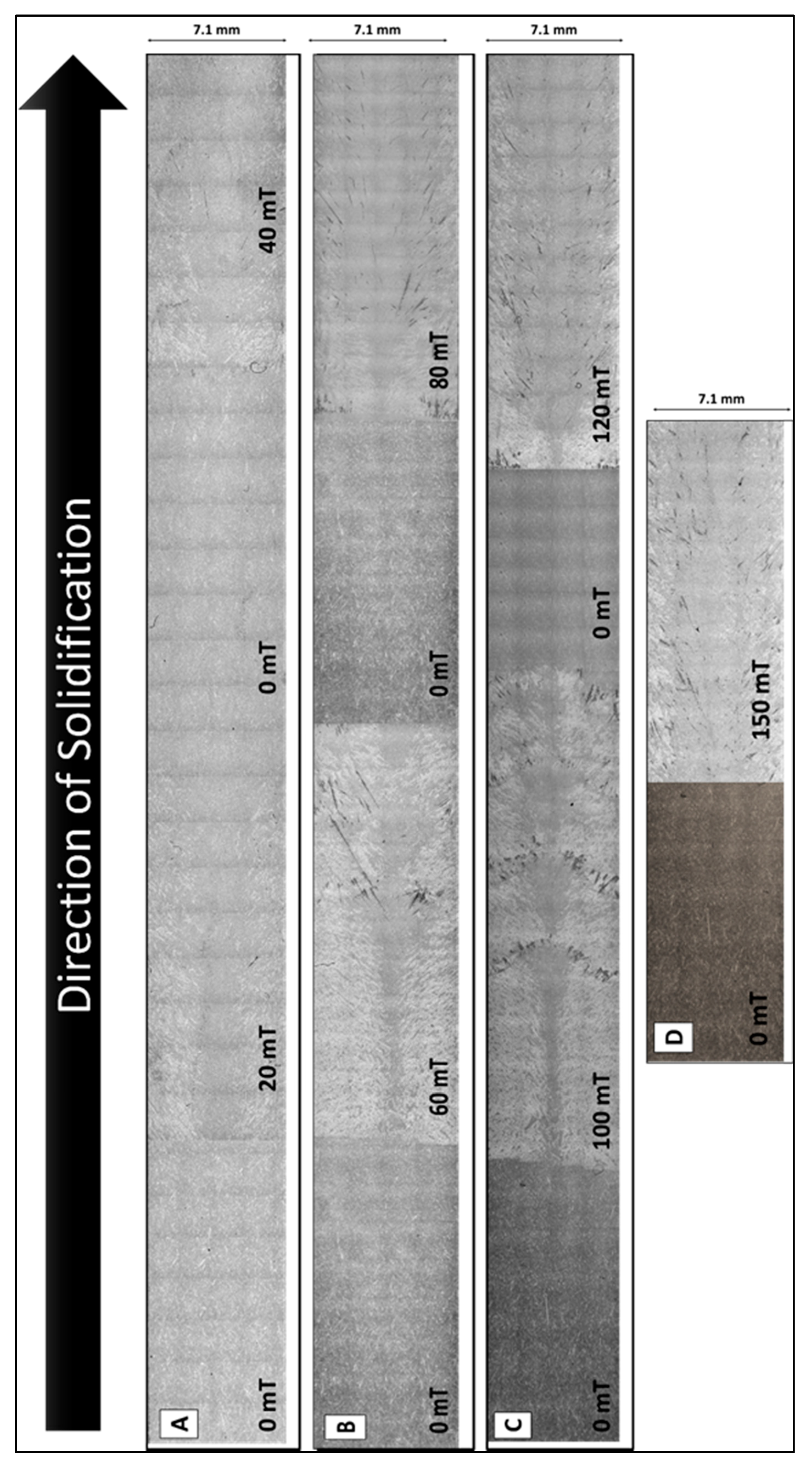

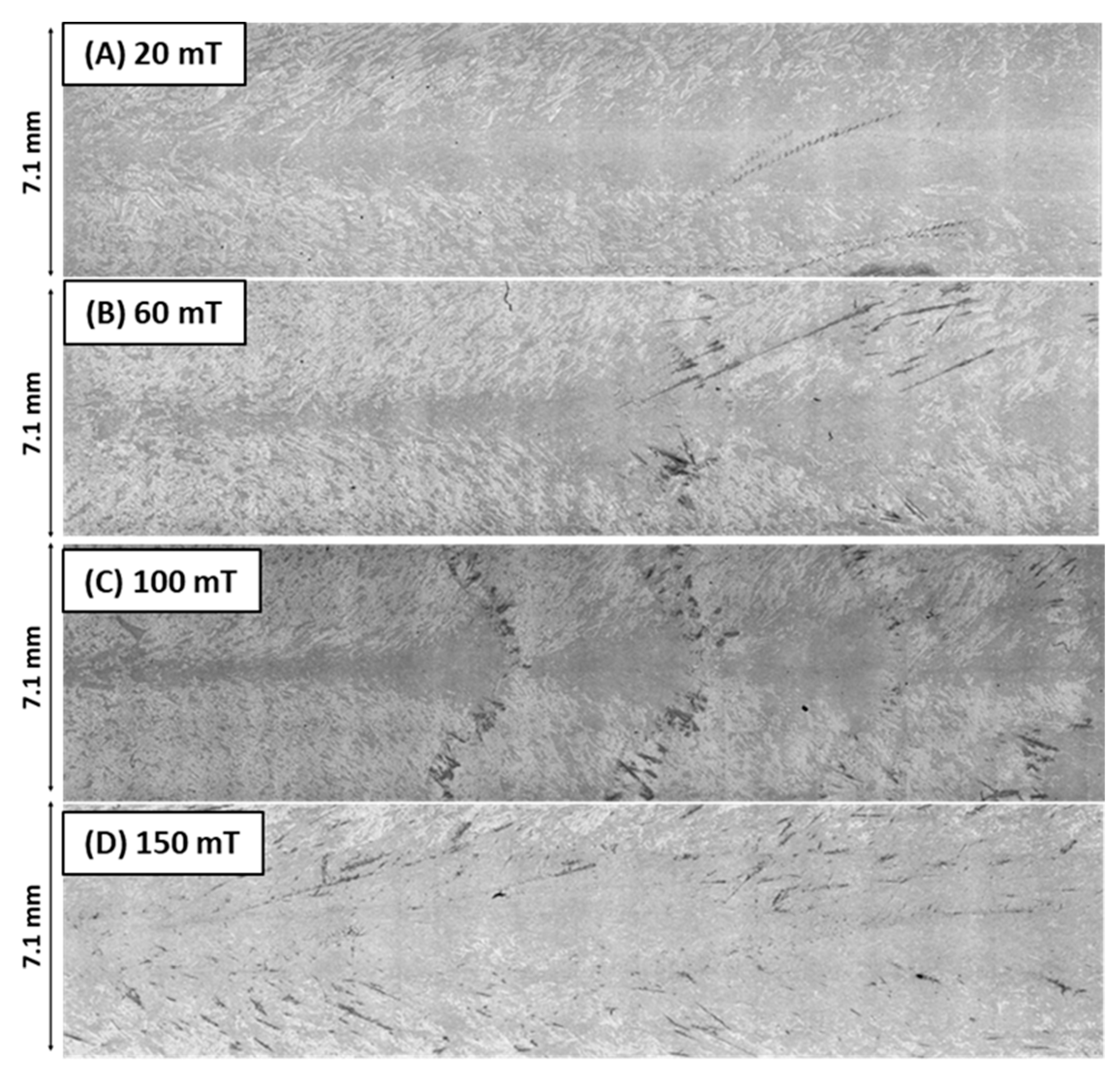
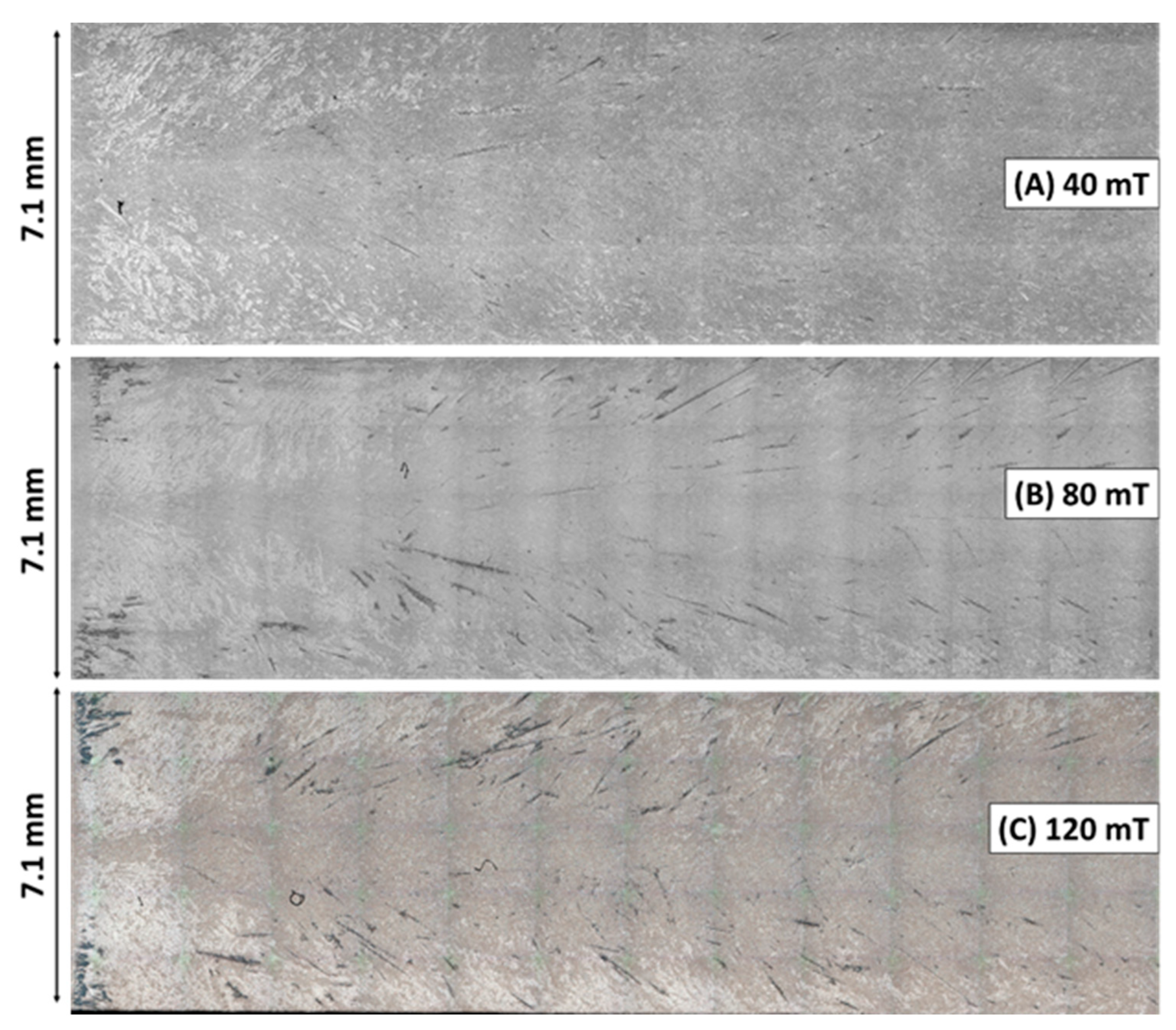
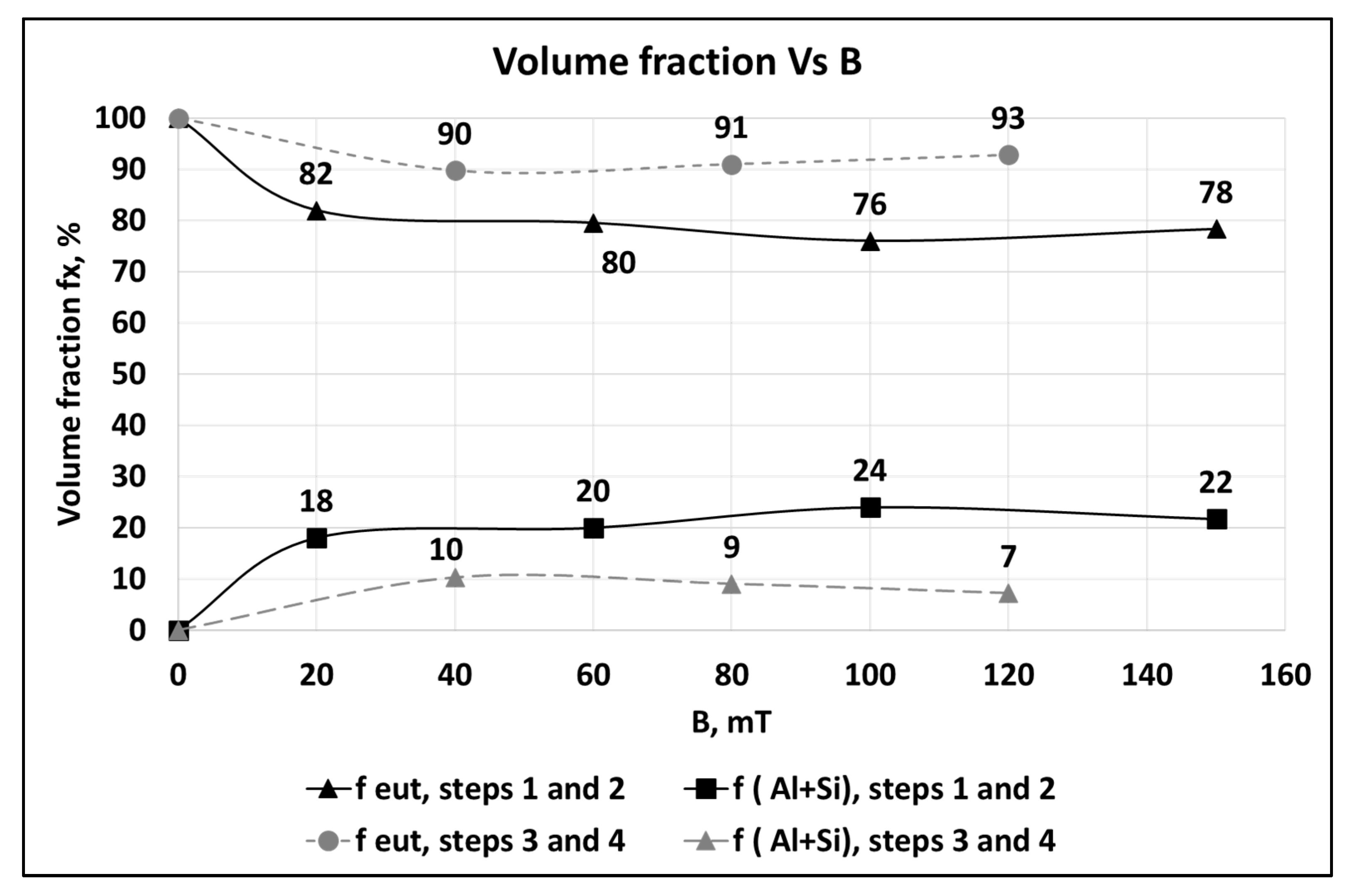

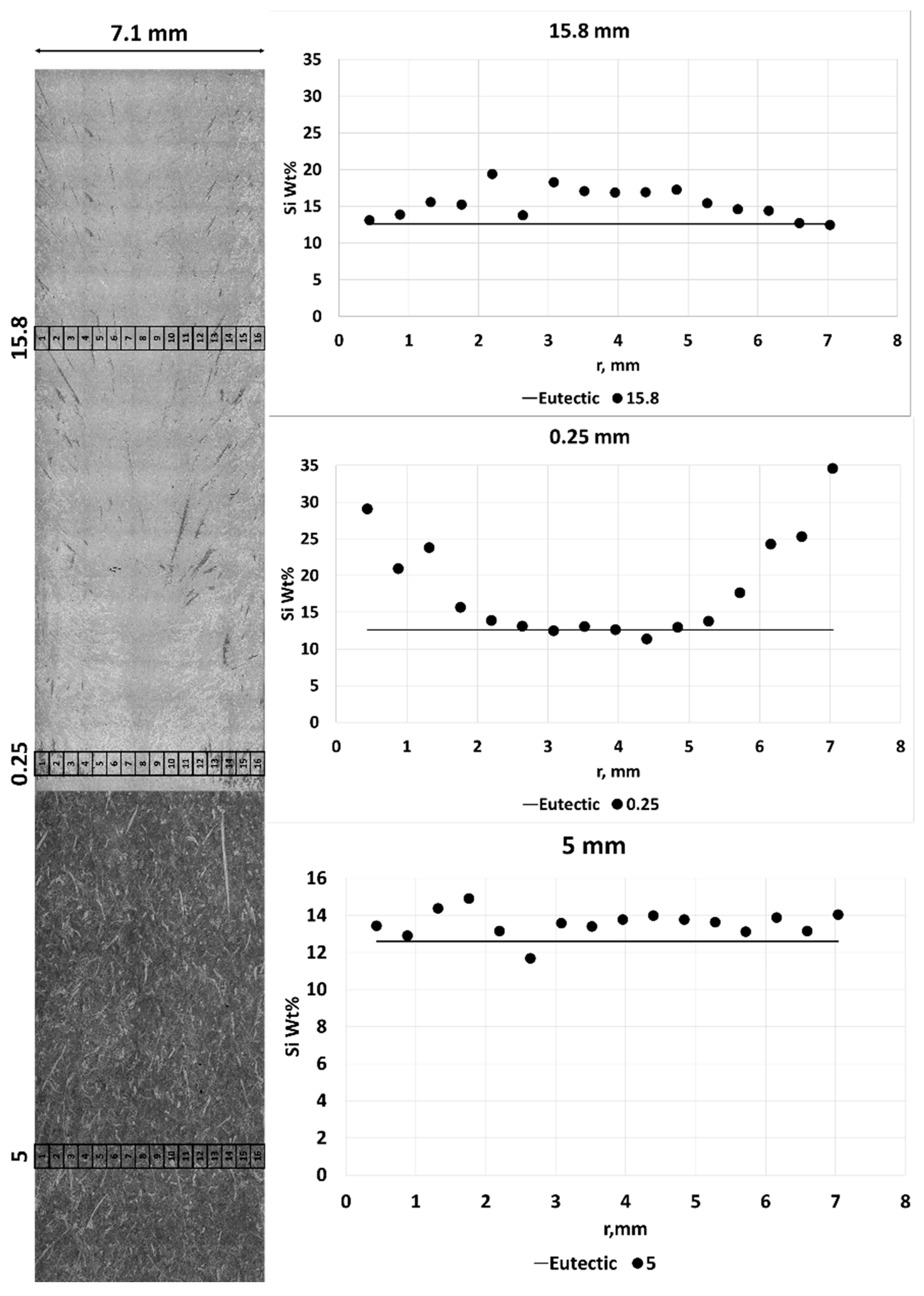
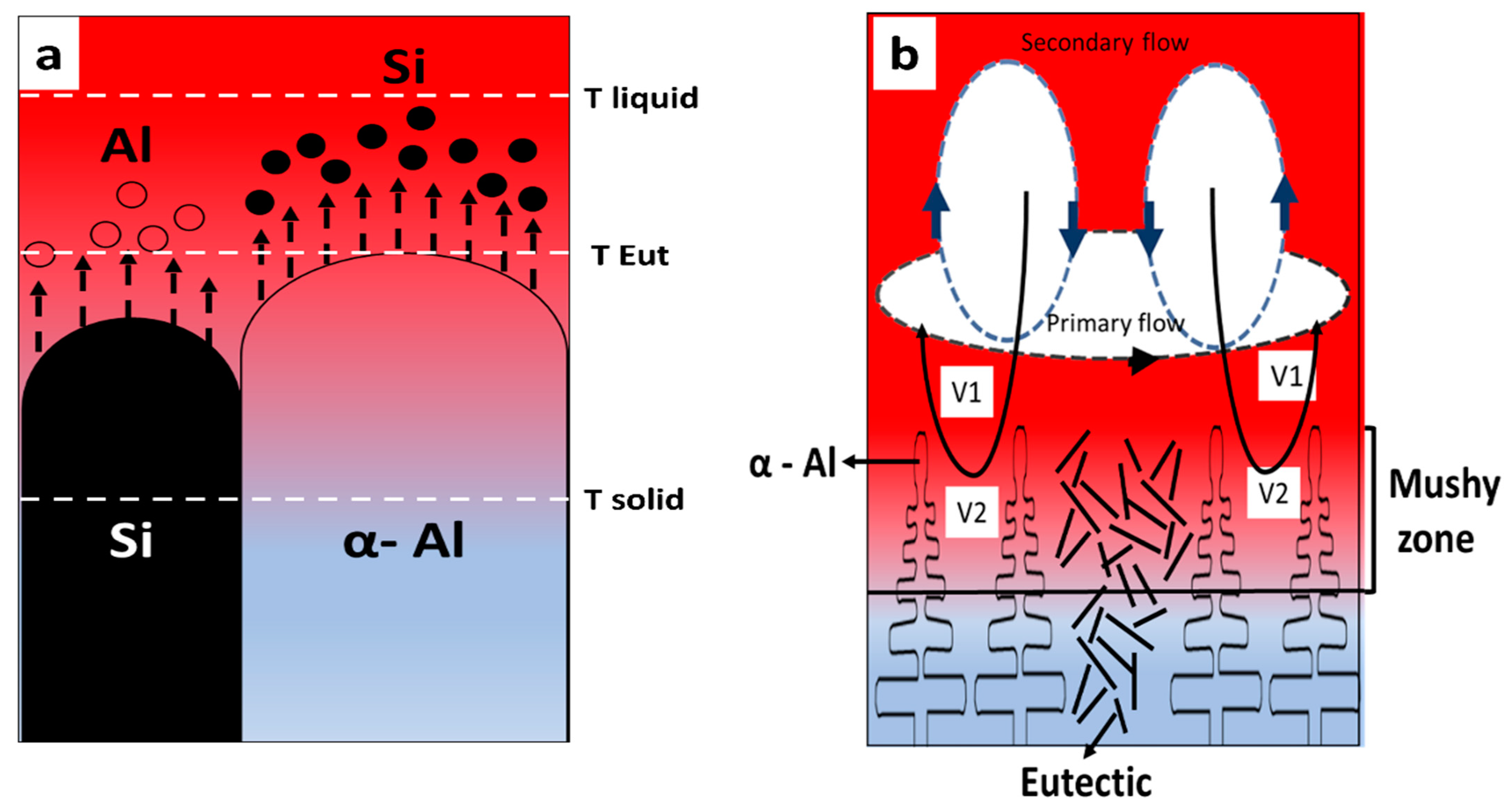
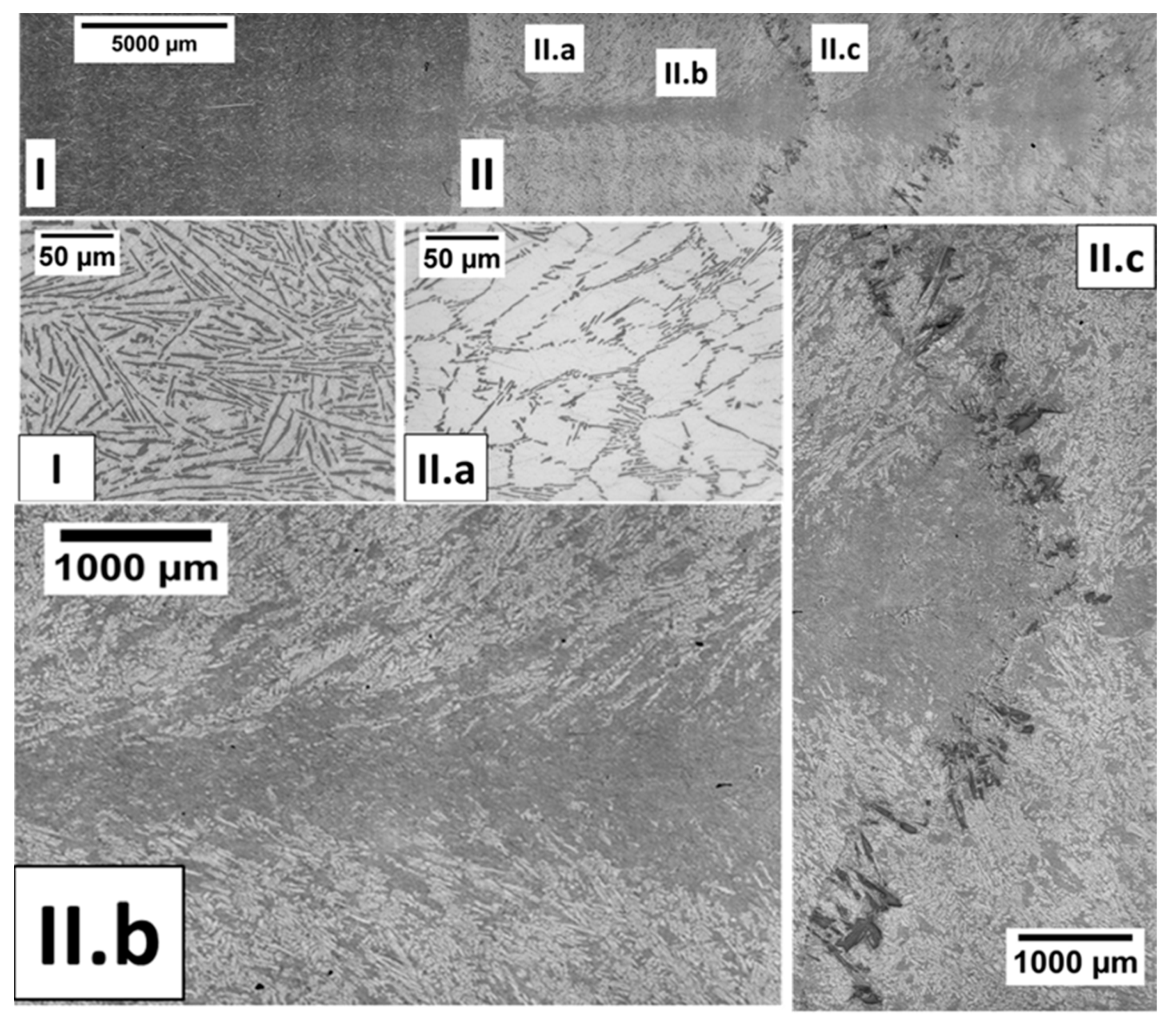
| Sample | B (mT) | |||
|---|---|---|---|---|
| Step 1 | Step 2 | Step 3 | Step 4 | |
| A | 0 | 20 | 0 | 40 |
| B | 0 | 60 | 0 | 80 |
| C | 0 | 100 | 0 | 120 |
| D * | 0 | 150 | N/A | N/A |
Publisher’s Note: MDPI stays neutral with regard to jurisdictional claims in published maps and institutional affiliations. |
© 2022 by the authors. Licensee MDPI, Basel, Switzerland. This article is an open access article distributed under the terms and conditions of the Creative Commons Attribution (CC BY) license (https://creativecommons.org/licenses/by/4.0/).
Share and Cite
Al-Omari, K.; Roósz, A.; Rónaföldi, A.; Svéda, M.; Veres, Z. Macrosegregation Evolution in Eutectic Al-Si Alloy under the Influence of a Rotational Magnetic Field. Metals 2022, 12, 1990. https://doi.org/10.3390/met12111990
Al-Omari K, Roósz A, Rónaföldi A, Svéda M, Veres Z. Macrosegregation Evolution in Eutectic Al-Si Alloy under the Influence of a Rotational Magnetic Field. Metals. 2022; 12(11):1990. https://doi.org/10.3390/met12111990
Chicago/Turabian StyleAl-Omari, Kassab, András Roósz, Arnold Rónaföldi, Mária Svéda, and Zsolt Veres. 2022. "Macrosegregation Evolution in Eutectic Al-Si Alloy under the Influence of a Rotational Magnetic Field" Metals 12, no. 11: 1990. https://doi.org/10.3390/met12111990
APA StyleAl-Omari, K., Roósz, A., Rónaföldi, A., Svéda, M., & Veres, Z. (2022). Macrosegregation Evolution in Eutectic Al-Si Alloy under the Influence of a Rotational Magnetic Field. Metals, 12(11), 1990. https://doi.org/10.3390/met12111990






